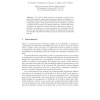64
Voted
ICRA
2003
IEEE
15 years 6 months ago
2003
IEEE
Much of the current research in human-robot interaction is concerned with single systems and single or few users. These systems and their interfaces are generally tightly-coupled ...
78
Voted
ICDCSW
2003
IEEE
15 years 6 months ago
2003
IEEE
— Systems are more and more expected to work in dynamic environment, to deal with fluctuation of their characteristics and to guaranty functional and nonfunctional requirements. ...
113
click to vote
SEM
2004
Springer
15 years 6 months ago
2004
Springer
The use of handheld networked devices to access information systems by people moving around is spreading rapidly. Systems being used in this way typically face dynamic variation in...
103
click to vote
MEMBRANE
2004
Springer
15 years 6 months ago
2004
Springer
Some computational aspects and behavioral patterns of P systems are considered, emphasizing dynamical properties that turn useful in characterizing the behavior of biological and b...
104
Voted
MEMBRANE
2004
Springer
15 years 6 months ago
2004
Springer
We proved that two classes of Communicative P systems with 3 membranes and with minimal cooperation, namely P systems with symport/antiport rules of size 1 and and P systems with s...
108
Voted
ICTAC
2004
Springer
15 years 6 months ago
2004
Springer
Abstract. P systems (known also as membrane systems) are biologically motivated theoretical models of distributed and parallel computing. The two most interesting questions in the ...
117
click to vote
GI
2004
Springer
15 years 6 months ago
2004
Springer
: The transition from microelectronics to nanoelectronics reaches physical limits and results in a paradigm shift in the design and fabrication of electronic circuits. The conserva...
111
Voted
FASE
2004
Springer
15 years 6 months ago
2004
Springer
Abstract. To be able to build systems by composing a variety of components dynamically, adding and removing as required, is desirable. Unfortunately systems with evolving architect...
99
Voted
ATAL
2004
Springer
15 years 6 months ago
2004
Springer
The ‘engineering’ and ‘adaptive’ approaches to system production are distinguished. It is argued that producing reliable self-organised software systems (SOSS) will necessa...
82
Voted
DSOM
2005
Springer
15 years 6 months ago
2005
Springer
Dynamic provisioning systems change application capacity in order to use enough resources to accommodate current load. Rejuvenation systems detect/forecast software failures and te...


